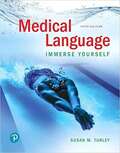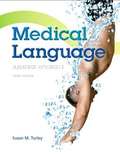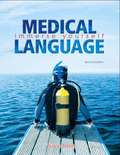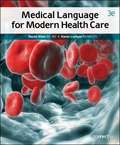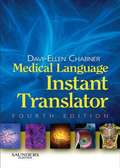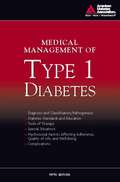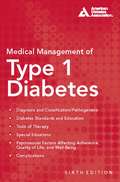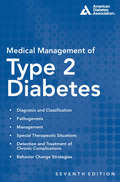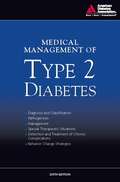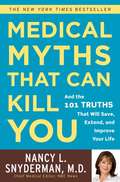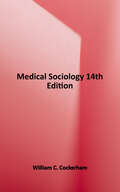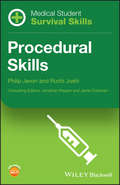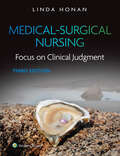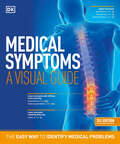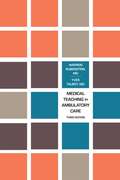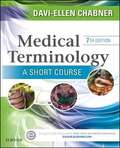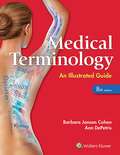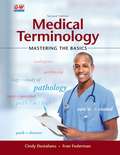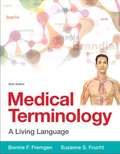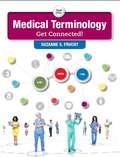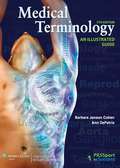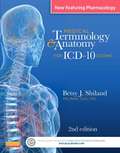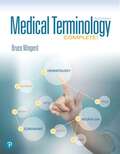- Table View
- List View
Medical Language: Immerse Yourself
by Susan TurleyFor courses in medical terminology. <p><p> An immersive deep-dive into medical terminology Medical Language: Immerse Yourself is grounded in immersive language learning. Rather than memorizing vocabulary, students experience the sights and sounds of health care as they listen, speak, write, watch, examine, and think. A greater quantity and variety of exercises than any other text maximize opportunities to reinforce learning. The 5th edition retains its organization by medical specialty ― the way medicine is practiced in the real world. New to the 5th edition is a reorganization into 15 chapters, perfect for a 16-week course, and into five sections correlated with learning outcomes. Each section ends with new Practice Laps evaluating student competency and underscoring learning goals.
Medical Language: Immerse Yourself (Third Edition)
by Susan M. TurleyNow in its Third Edition,Medical Language has touched the lives of more people than any other medical terminology book. This intensely visual, powerfully relevant book is organized to promote exceptionally effective instruction and maximum student success. Fully updated to cover the field's newest terminology, this edition retains a deep focus on word building, and enhances teaching and learning in many ways -- including a state-of-the-art immersive online study experience. Its appealing, uncluttered design contains hundreds of rich images and plenty of white space for easy reading and note taking. Student learning is promoted through an unsurpassed quantity and variety of exercises, more colorful, interesting, and large illustrations, and - as requested by most instructors - an intuitive organization around medical specialties. In addition to content updates throughout, this edition is complemented by a brand new set of Dynamic Lectures: comprehensive audio/visual learning experiences narrated by the author.
Medical Language (2nd Edition)
by Susan M. TurleyMedical Language is a medical terminology text that truly immerses readers within the language of medicine, so that students can apply their vocabulary within a real-world context. As opposed to fostering rote memorization, this book engages students in an interactive learning experience that will give them a vital tool and inspire them to become truly proficient in medical language.
Medical Language For Modern Health Care (Third Edition)
by David Allan Karen LockyerMedical Language for Modern Health Care, third Edition, uses a Contextual Learning approach to introduce medical terminology within a healthcare environment. Chapters are broken into lessons that present and define terminology through the context of A & P, pathology, as well as clinical and diagnostic procedures. The text is setup in a way that covers one topic at a time, offering contextual content, tables, and exercises all in one place. Word Analysis and Definition Tables provide a color-coded guide to word parts and combining forms, as well as definitions and pronunciations. Now featuring newly added chapters covering Geriatrics, Oncology, Radiology, and Pharmacology. With unfolding patient case studies and documentation, students are introduced to various roles in the healthcare environment, illustrating the real-life application of medical terminology.
Medical Language Instant Translator
by Davi-Ellen ChabnerCommunicate more effectively when you use this pocket reference to medical terms and other useful information! Davi-Ellen Chabner's Medical Language Instant Translator, 4th Edition provides the tools you need to understand medical terminology. You can also access key information on common diagnostic tests and procedures, the top 100 prescription drugs, medical abbreviations, symbols, and acronyms - and much more. Based on Chabner's The Language of Medicine, this practical resource is ideal for any health care environment!Get quick, portable access to key medical terms and other need-to-know information. Decipher complicated medical terms by recognizing and finding the meanings of individual word parts. Distinguish between commonly misunderstood medical terms (e.g., ureter vs. urethra, or para vs. peri). Become familiar with common diagnostic tests and procedures and why they are ordered. Access information on medical abbreviations, symbols, acronyms, and professional designations. Understand the basics of surgical instruments, terminology, and technology. Identify the top 100 prescription drugs and their uses. Quickly access the top 100 diagnoses and associated procedures. Find the definitions of complementary and alternative medicine terms. Recognize specialized terms used in medical records. Review body systems anatomy with full-color illustrations.Adds a new section on eponyms -words based on or derived from a person's name. Adds a new section on Major Diagnostic Categories & Diagnosis-Related Groups (DRG). Includes updates corresponding to those in the Language of Medicine, 9th Edition, by Davi-Ellen Chabner.
Medical Management of Type 1 Diabetes
by American Diabetes Association Francine R. KaufmanA comprehensive resource for health care professionals that outlines the American Diabetes Association®'s recommended course of diagnosing and treating patients with type 1 diabetes. This comprehensive volume provides the basis for individualized, flexible, responsive treatment plans for patients with type 1 diabetes. It includes integrated approaches on blood pressure and lipid goals, proper nutrition, exercise, smoking cessation, and more. All based on the clinical practice recommendations of the American Diabetes Association®.
Medical Management of Type 1 Diabetes
by Francine R. KaufmanType 1 diabetes, formerly known as juvenile diabetes, is a complex disorder that requires a great deal of patient-guided self-care. In recent years, advances in diabetes treatment have dramatically shifted potential outcomes in the favor of the patient with diabetes. The challenge for health care professionals is to realize this potential through an individualized, flexible, and responsive treatment plan for patients with type 1 diabetes.Now in its sixth edition, Medical Management of Type 1 Diabetes offers health care providers the newest information and guidelines for the treatment of type 1 diabetes. Built on the foundation of multiple daily insulin injections and insulin pump therapy, this book guides health care providers in helping their patients continually strive for optimal blood glucose control. This new edition focuses on the latest molecular advances, new treatment methods, recent clinical trials, and the American Diabetes Association's Standards of Care. Key topics also include new insulins and administration protocols, advanced carbohydrate counting, and emphasis on continuing patient education.Individual sections address all of the topics in managing type 1 diabetes, including:Diagnosis and Classification/PathogenesisDiabetes Standards and EducationTools of TherapySpecial SituationsPsychosocial Factors Affecting Adherence, Quality of Life, and Well-BeingComplicationsEdited by Dr. Francine Kaufman, a widely recognized expert in the treatment of diabetes and of insulin therapy, and guided by the recognized authority of the American Diabetes Association's Standards of Care, Medical Management of Type 1 Diabetes is an essential addition to any clinician's library for the treatment and understanding of type 1 diabetes.
Medical Management of Type 2 Diabetes
by Charles F. BurantAs type 2 diabetes continues its rise in prevalence worldwide, there is an increasing need to study it and describe successful treatments. There are several options for treatment, including oral medications, diet and lifestyle modification, and insulin therapy. Knowing which method to select and how to apply it relies on several clinical guidelines that are updated every year by the American Diabetes Association.This new edition of Medical Management of Type 2 Diabetes provides care providers with the answers to their questions about implementing care. All of the contributors are experts in their fields, and they define the disease, including the progressive nature of type 2 diabetes; cardiovascular, microvascular, and neurological complications; care methodologies for special situations; and behavior change. All guidelines and standards have been updated with the latest developments in research, advances in medications and medical devices, and new understandings of how to effectively work with the patient.
Medical Management of Type 2 Diabetes
by Charles F. Burant American Diabetes AssociationThis clinical book for health care professionals features the most up-to-date approaches and protocols for diagnosing and treating patients with type 2 diabetes.Over 18 million people are living with diabetes and the majority have been diagnosed as type 2-a group particularly at-risk for cardiovascular complications. Health care practitioners will find this comprehensive resource for type 2 indispensable, providing the most up-to-date guidelines for diagnosis, treatment, glucose, and cardiovascular disease risk factor control as well as nutrition and exercise. Professionals will find the array of treatment options for all stages of cardiovascular disease particularly useful, as well as the behavior modification strategies.
Medical Myths That Can Kill You: And the 101 Truths That Will Save, Extend, and Improve Your Life
by Nancy L. Snyderman"Do you know what's really good for you?" In this age of countless miracle cures, it's vital to separate the myths that endanger your health from the medical truths you need. TRUTH: Unfiltered coffee can clog your arteries. TRUTH: Tossing and turning at night may shorten your life. TRUTH: Boring jobs can kill you. Get the information you need to revitalize your body, maintain your longevity, manage your health care, and possibly even save a life--yours.
Medical Sociology, Fourteenth Edition
by William C. CockerhamThe most thorough major academic textbook available, this classic text presents the most important research studies in the field. The author also integrates engaging first-person accounts from patients, physicians, and other healthcare providers throughout the text. A much greater number of first-person accounts and updated examples are added to the new fourteenth edition. Other updates include: - Coverage of Zika, Ebola, MERS, and updates on other pandemics - Expanded discussion of obesity as a disease - Coverage of the widening gap in life expectancy between the rich and the poor - New information on the decline of life expectancy among American white women, especially those who live in rural counties - New material on biomarkers, gene-environment interaction, and stress - Analysis of the role of the hidden curriculum in medical schools - Exiting the Affordable Care Act
Medical Student Survival Skills: Procedural Skills (Medical Student Survival Skills)
by Phil Jevon Ruchi JoshiMedical students encounter many challenges on their path to success, from managing their time, applying theory to practice, and passing exams. The Medical Student Survival Skills series helps medical students navigate core subjects of the curriculum, providing accessible short reference guides for OSCE preparation and hospital placements. These guides are the perfect tool for achieving clinical success.
Medical-Surgical Nursing: Focus on Clinical Judgment
by Linda HonanConfidently meet the demands of transitioning students into practice-ready nurses with Medical-Surgical Nursing: Focus on Clinical Judgment, 3rd Edition. Expertly curated by experienced clinician and nursing educator Dr. Linda Honan, this practical approach distills complex concepts down to need-to-know details through the perspective of practicing nurses, establishing a comprehensive foundation in medical-surgical nursing by way of the most commonly encountered conditions and situations. Extensive updates throughout this 3rd Edition broaden your students’ perspectives, cultivate their clinical judgment, and prepare them for success from the Next Generation NCLEX® to the day-to-day challenges of today’s medical-surgical nursing practice.
Medical Symptoms: The Easy Way to Identify Medical Problems (DK Medical Care Guides)
by DKFind home remedies and advice on illnesses and injuries! There are plenty of medical scenarios that can be identified and treated at home. This medical reference book takes you through the most common illnesses and injuries, their symptoms, locations in the body, how to treat them at home and when to seek professional medical attention.Inside this first aid guide, you&’ll find: • Easy-to-access visual symptoms guide, arranged by body part affected, working from head to toe • Intuitive entry-level helps the reader identify illness or locate injury quickly • Clear, simple illustrations of the associated anatomy help medical understanding • Conditions are listed in order of likelihood, with the most likely first, for speedy diagnosis • Symbols direct a reader to the appropriate form of medical help • Concise explanations of all the conditions featured in the diseases and disorders section • Updated to include Covid-19 Medical Symptoms is an easy-to-use visual symptoms finder and self-diagnosis book that will help you check out any health problem. Discover what an ailment or pain might be and what you should do. You&’ll find explanations of symptoms and diseases, clear human anatomy photographs, and suggested home care instructions. Once you&’ve narrowed it down, a cross-reference takes you to easy-to-follow descriptions of the condition at the back of the book. Potentially life-threatening situations symptoms that need urgent medical advice are clearly flagged. This is the perfect home medical guide for your family and is fully illustrated throughout.
Medical Teaching in Ambulatory Care, Third Edition
by Warren Rubenstein Yves TalbotA practical, hands-on resource for physicians in all specialties, Medical Teaching in Ambulatory Care is a guide on training medical students and residents in settings such as private practices and hospital clinics. Concise, engaging, and easy to follow, it is an ideal handbook for the busy practitioner looking to upgrade his or her teaching abilities.The authors cover basic education theory, individual teaching skills, strategies for evaluating trainees, and tips on working with challenging learners. Readers can follow along with the storyline of a fictional Dr. Smith, through whom the book provides practical examples that complement each theory, skill, and strategy presented.This new edition has been updated with key medical education theories that are now core to current approaches, expanded details on one-to-one teaching, and information on structured formats to use when reviewing patient encounters with learners. The authors also examine the impact of digital technology on medical education in office-based settings and provide tips on working with the new generation of learners who enjoy - and expect - instant access to information of all kinds.
Medical Terminology: A Short Course (7th Edition)
by Davi-Ellen ChabnerQuickly master the basics of medical terminology and begin speaking and writing terms almost immediately! Using Davi-Ellen Chabner's proven learning method, Medical Terminology: A Short Course, 7th Edition omits time-consuming, nonessential information and helps you build a working medical vocabulary of the most frequently encountered prefixes, suffixes, and word roots. Medical terms are introduced in the context of human anatomy and physiology to help you understand exactly what they mean, and case studies, vignettes, and activities demonstrate how they're used in practice. With all this plus medical animations, word games, and flash cards on the Evolve companion website, you'll be amazed at how easily medical terminology becomes part of your vocabulary.
Medical Terminology: An Illustrated Guide
by Barbara Cohen Ann DePetrisNow packed with new illustrations and more clinically relevant than ever before, this fully updated Eighth Edition of Medical Terminology: An Illustrated Guide helps readers develop a fundamental knowledge of the medical terminology necessary for a career in any health care setting. To help students learn both medical terms and how they are used in real-world settings, this reader-friendly book demonstrates how medical terms are built from word parts (Part 1), introduces body structures, diseases, and treatments (Part 2), and covers each body system (Part 3). Accessible content, a logical organization, and reinforcing drills in every chapter combine to help readers master the information they need for success in their future careers. An enhanced art program, many new, clinically focused case studies, and an improved online teaching and learning resources (including PrepU adaptive quizzing) make this Eighth Edition ideal for classroom instruction, independent study, or distance learning. · Greater Student Confidence = Success: Use of Barbara Cohen's Memmlers Anatomy and Physiology along with this Medical Terminology text delivers continuity of writing style, design, and online resources making students more confident and ultimately more successful in their chosen health profession. · A greater emphasis on clinical illustrations brings concepts to life and helps students connect learning to practice. · Updated cases studies focus on current issues and hot topics to prepare students for the types of challenges they will encounter in practice. · PrepU is featured in the Ancillaries-at-a-Glance section and is identified with an icon throughout the text. · Online Student Resources have been updated and enhanced. · Online Lesson Plans have been updated with tips on using the book in a flipped classroom or in online learning.
Medical Terminology: Mastering the Basics
by Cindy Destafano Fran FedermanMedical Terminology: Mastering the Basics presents a solid introduction to basic medical terminology, providing you with the skills to communicate effectively using medical language in the healthcare field. Organized by body system, this work text covers essential root words, prefixes, suffixes, and abbreviations. It also summarizes basic anatomy and physiology, common diseases and disorders, diagnostic tests and procedures, and therapeutic treatments. Through completing numerous activities, you will learn the meanings of the word parts and will practice spelling, pronouncing, breaking down, and building medical terms. You will not only learn, but will also practice, using these terms to interpret examples of written and audio medical records you will encounter in healthcare.
Medical Terminology: A Living Language
by Bonnie F. Fremgen Suzanne S. FruchtWith 14 streamlined chapters covering essential A&P topics, this mid-sized book is the perfect fit for a one-semester course in medical terminology. It also serves as a useful reference for practicing professionals. Build a strong foundation of medical terminology, step by step Medical Terminology: A Living Language uses a carefully constructed learning system to help readers gain a successful grasp of medical language within a real-world context. Its step-by-step approach introduces the anatomy and physiology of body systems and their corresponding medical terms, as well as the rules of using word parts to form medical terms. New exercises and tips give readers the hands-on practice they need to achieve mastery. Rather than simply memorizing terms, students will gain the understanding to work with all terminology, regardless of its etymology or origins, so they can interpret unfamiliar terms they will encounter in the future. Also available with MyMedicalTerminologyLab(tm) This title is also available with MyMedicalTerminologyLab-an online homework, tutorial, and assessment program designed to work with this text to engage students and improve results. Within its structured environment, students practice what they learn, test their understanding, and pursue a personalized study plan that helps them better absorb course material and understand difficult concepts. No matter their learning style, students will build a solid foundation of medical language through MyMedicalTerminologyLab's interactive games, Dynamic Study Modules, and narrated lectures. NOTE: You are purchasing a standalone product; MyMedicalTerminologyLab does not come packaged with this content. MyMedicalTerminologyLab should only be purchased when required by an instructor.
Medical Terminology: A Living Language
by Bonnie F. Fremgen Suzanne S. Frucht Marcelo OliverNIMAC-sourced textbook
Medical Terminology: Get Connected!
by Suzanne FruchtA fun, accessible way to connect with medical terminology Successful healthcare professionals make connections every day--whether it is connecting word parts to make medical terms, recognizing the interconnectedness of body structures and systems, or communicating with colleagues and patients. Medical Terminology: Get Connected prepares readers to make these connections. Designed to be fun, accessible, and eye-catching, its powerful approach guides students step-by-step through mastering relevant word parts, understanding word roots, and word assembly. To help students learn meanings, correct spelling, pronunciation, and other components of each term, the book contains numerous exercises, tips, and colorful figures. As they practice and apply what they read, students will learn to build, translate, and link medical terms with confidence.
Medical Terminology 350: Learning Guide (2nd Edition)
by Dean VaughnThe purpose of this book is to teach you the basic design of medical terminology and how to easily remember the meanings of 350 Latin and Greek word parts or elements.
Medical Terminology,7th Edition,An Illustrated Guide
by Barbara Janson Cohen Ann DepetrisMedical Terminology: An Illustrated Guide, 7e by Barbara Janson Cohen uses a stepwise approach to learning medical terminology. Part 1 describes how medical terms are built from word parts; Part 2 introduces body structures, diseases, and treatments; and Part 3 describes each body system. Individual chapters also build on knowledge in stages: the Key Terms sections list the terms most commonly used; more specialized terms are included in a later section entitled “Supplementary Terms.”<P> The current edition includes a robust student ancillary package delivered under the PASSport to Success brand, with assessment exercises, chapter quizzes, and searchable text online, and a complete suite of instructor resources. The addition of PrepU as a packaging option provides a powerful value to students - the online study experience helps them to understand and retain course information and helps instructors to better assess what their students may be struggling with.
Medical Terminology And Anatomy For ICD-10 Coding (Second Edition)
by Betsy J. ShilandMedical Terminology and Anatomy for ICD-10 Coding integrates expanded anatomy, physiology, and pharmacology coverage with the latest medical terminology you need to correctly code in ICD-10. The ICD-10-CM classification system serves as the structure for organizing diseases and disorders, with carefully drawn, well-labeled illustrations to help you visualize the associated anatomy. ICD-10 coding guidelines and notes, along with electronic medical records and integrated exercises are interspersed throughout the text. A robust Evolve site includes games, activities, and animations to reinforce learning. Medical terminology specifically tailored to ICD-10-CM and ICD-10-PCS guidelines supply you with an excellent foundation for learning the medical terminology related to ICD-10-CM. Learn all the anatomy and physiology necessary to be able to understand medical reports and code accurately in ICD-10-CM/PCS. Pathology terms organized by ICD-10 disease and disorder categories let you learn terms in the same order they are presented in the coding manual. Guideline Alert! boxes highlight ICD-10-PCS coding information when relevant to medical terminology. Special Notes boxes present ICD-10 features that affect your understanding of the terminology presented. Root operation tables illustrate the root operations in PCS and their associated suffixes. Body Part key provides a complete list of body parts and how they should be coded in ICD-10. Pathology and procedure terminology tables list the word parts for each term, along with the definition so you become familiar with prefixes, suffixes, and combining forms. Exercises interspersed throughout the text encourage you to practice and learn as you move through the material. Be Careful! boxes warn you about similar and potentially confusing word parts and medical terms. Games and activities on accompanying Evolve website offer an easily accessible source for extra interactive practice and learning. Electronic medical record format illustrates the appearance of electronic records now being used in many healthcare settings. NEW! Pharmacology in each body system and a Pharmacology Basics appendix help you recognize drugs and medications in medical reports. NEW! More than 50 new images bring terminology to life. NEW! Additional procedural terms supply a more complete picture of the number and kind of procedures you will encounter on medical reports. NEW! Normal Lab Values appendix familiarizes you with normal and abnormal lab values so you know when to search a medical record for possible additional diagnoses. NEW! Tablet and mobile-optimized Evolve activities offer an easily accessible source for extra interactive practice and learning.
Medical Terminology Complete!
by Bruce WingerdMedical Terminology Complete! takes a programmed approach to presenting the most current language of healthcare. Organized by body system, the text conveys the medical terms used in medical offices, hospitals and clinics, together with essential A&P information. You'll get step-by-step guidance in building medical terms. Word Part Reminders show you how word parts combine to form a term, while Word Part Breakdowns identify word parts. Some exercises offer word-building practice, while others use medical reports to show how medical terms are used in practice. The 4th Edition improves clinical training for students poised to a launch a healthcare career. New types of chapter-ending exercises, such as Define the Combining Form and Complete the Labels exercises, round out a comprehensive series of practice opportunities.
